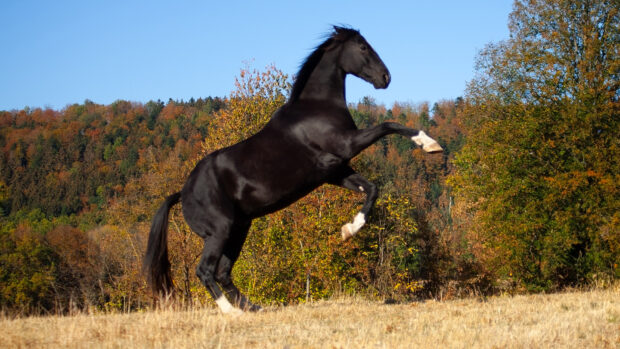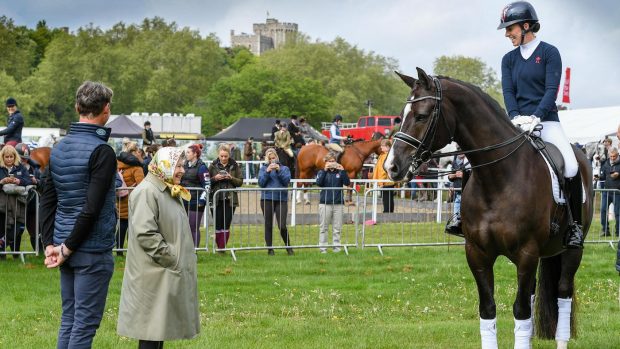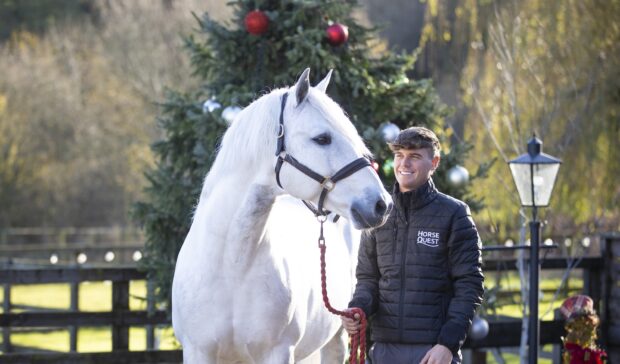Can a stabled horse truly be a happy one? This was the question debated by equine welfare, behaviour and veterinary experts at a webinar hosted by World Horse Welfare on 9 March.
Andrew McLean, an award-winning animal behaviour scientist and former top-level eventer, showjumper and dressage rider, gave a presentation on why horses may respond in certain ways to being stabled — and what we can change to benefit their physical and mental health.
“This is a fascinating topic, and there are no right or wrong answers,” Dr McLean said, adding that it can be hard to tell whether a person is happy, let alone an animal.
He said as horses have become domestic animals, their habits have changed, so “there’s an argument they could be happy enough in a stable, though it’s unlikely a zebra would ever be”.
Dr McLean looked at horses’ brains and their ability to experience different feelings, explaining that they live far more in the moment than humans, “which is a great way to be”.
He said much of equine happiness is to do with enabling horses to meet their “fundamental needs”, not only such as nutrition and water, but also the “pillars”: communication and mental stimulation, the horse’s need to forage and for movement and exercise.
“The fourth pillar, social behaviour, is absolutely fundamental,” he said. “Horses, like humans, are hyper-social animals and their social needs are mediated by touch, not just seeing. That’s where stabling comes in, and how we design stables for the future.”
Dr McLean said stable mirrors and toys can help horses, but that access to other equids has a huge effect; mutual grooming is important. He cited work he had done with a mounted police section, who he asked to remove the bars between the horses’ stables. After some initial “ruckus”, the horses were much calmer on patrol, and spent a great deal of time in the stables touching.
“Someone who works for a big trainer tells me some of the old stables’ bricks have fallen out, and the first thing the horses do after work is go to touch and sniff other horses through the holes; so strong is the need for social behaviour. I think it’s essential to give the horse more access to social partners. I don’t think stabling is nearly as bad if they can touch each other. Seeing isn’t enough.”
Dr McLean said equestrian architect Luke Jones has designed a number of options for stables that allow physical contact, but can be closed off to isolate horses if needed, and also allow horses to retreat if they want to.
“Bars are normal and people feel comfortable with that. And for many, that’s a happy horse in its beautiful stable that cost a fortune, with ample bedding and all those good things, but whether that makes the horse happy or not is questionable,” he said.
“If our horses are shying, 99% of people think he’s scared of cats or plastic bags, but it may very well be for deeper reasons; that there are big holes in that horse’s basic life, and this is one big hole.”
Dr McLean said we can “do all sorts of things” to make stables better, which need not be expensive.
“I think we can make a big difference to horses’ lives, if we do need to stable them, by giving them more access to other horses, and there are many ways to do this.”
In a session for questions, World Horse Welfare CEO Roly Owers asked whether there is a danger of anthropomorphism if horses are described as happy or unhappy.
Vet Brad Hill, from Nottingham Vet School, said clients will often judge whether their horses are happy. Often the person spending the most time with a horse knows it the best, and it can be hard if a vet “comes along saying it’s not”.
“Hopefully, with a bit of education like Andrew’s given us, we can take a broader view, and take off the rose-tinted glasses we tend to wear with our own horses,” he said.
Eileen Gillen, manager of World Horse Welfare’s Belwade Farm, spoke of habituation; citing a case of 14 colts who were rescued having always lived in a barn,
“We thought what they needed was to go out and be ponies,” she said. “When we opened the doors to the outside world, the colts didn’t know what to do. The first time they felt rain, they scurried back into the barn. It opened my eyes to see how habituation had been put into those young beings. I tried to educate them to be what we think are horses, but everyone’s opinion matters and there’s always a case that will tell you something different.”
Mr Owers asked whether “keeping a horse in 24/7 is ever OK”, and Ms Gillen said the charity gets calls about this, which “we take seriously”.
“But how one thinks we’d like our own horses to be kept isn’t others’ opinions,” she said, adding that the charity has to work within the law. “Sometimes we have to think about how we can best help situations,” and ask whether the animal has good quality of life, if it is well stimulated and in good condition as its environment may not be outside the law.
“There are always different ways to look after a horse,” she said. “We have to look at all the consequences and what’s best for that horse at that time. Is it compromised? No, move on, but let’s see how else we can help.”
You might also be interested in:

Top rider explains turnout opinion after social media ‘wolf pack’ storm
“They probably get out more than an average horse who spends a couple of hours in a paddock”

Turning horses out: 24/7, part-time or not at all? Here are the pros and cons…

Subscribe to Horse & Hound magazine today – and enjoy unlimited website access all year round




